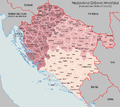Hrvatsko domobranstvo

The Croatian associations of Austria-Hungary ( ku Landwehr ) and the regular armed forces of the Independent State of Croatia (NDH) were called Hrvatsko domobranstvo (Croatian Home Guard).
The term for the members of the Hrvatsko domobranstvo , namely Domobrani ( Croatian singular : domobran = home defender) is used more often. Is erroneously Croatian domobranstvo also often translated as "Croatian Landwehr" although usually the term " militia called" the German-speaking associations with reduced combat effectiveness. However, this was not the case here. Although personnel weaker with only three battalions instead of four per infantry - regiment equipped with the units of the Joint Army , it was yet to regular combat troops.
founding
The ku Landwehr was divided into the Hungarian Landwehr and the Croatian-Slavonian Landwehr, whereby the Croats were granted the right in the " small compensation " of 1868 to introduce Croatian as the service and command language in their Honvéd units. In addition, the Croatian-Slavonian Honvéd units were subordinate to the Ban in Agram and not to the National Defense Minister in Budapest .
Farther:
- relatives were to serve exclusively in the territory of the Kingdom of Croatia and Slavonia
- the training of officers and non-commissioned officers took place exclusively in the Academy of Domobranen.
- the units were designated by Croatian names
Accordingly, Croatian associations were set up within the framework of the Royal Hungarian Landwehr , which bore the official name of the Croatian-Slavonian Landwehr .
First World War
Immediately before the outbreak of the First World War, the 42nd Division was set up, which was nicknamed "Devil's Division" because of its military successes. Under the leadership of Colonel General Stjepan Sarkotić, 14,000 men belonged to this division . This division excelled in taking Montenegro in 1916 .
Military service for conscripts lasted two years.
After the establishment of the Kingdom of Yugoslavia , the Croatian Home Guard was dissolved.
Second World War
As a result of the invasion of Yugoslavia by the German armed forces , a Croatian puppet state was founded. On April 16, 1941, under Slavko Kvaternik as commander in chief, the Hrvatsko domobranstvo with army , navy , air force , national guard , gendarmerie and labor service were formed as the regular armed forces of Croatia. You were instrumental in containing the first wave of uprisings in late summer and autumn 1941.
In accordance with the agreements concluded in 1942 and 1943, its operational management was taken over by the responsible German Army Group or the German Army High Command. Between November 1941 to May 1943 approximately 55,000 men in three were Army Corps with six infantry - divisions and a Mountain Division organized. In May 1943, the six divisions were converted into four mountain and four rifle brigades. On November 21, 1944, the Head of State took Ante Pavelić in command and ordered the merger of army units with the fascist Ustasha militia to oružane Hrvatske snage (Croatian Armed Forces). Combined, this resulted in a workforce of 16 divisions. In addition to Croats , Bosniaks , Serbs , Czechs , Slovaks , Ukrainians , Russians and members of other national minorities also served.
When the Yugoslav People's Liberation Army was victorious, the soldiers of the Domobrani fled with the government from Zagreb in the direction of Carinthia in May 1945 , where they surrendered unconditionally and were handed over to the Yugoslav government under Tito by the British army . As a result, the Bleiburg massacres took place .
gallery
First World War
Hussar of the Croatian-Slavonian Landwehr
Domobranen while exercising
Swearing-in of a Domobranen unit on the Kingdom of Serbs, Croats and Slovenes (Zagreb, November 1918)
Second World War
Domobranen officer Muhamed Hadžiefendić (1898–1943)
Domobran with the coat of arms of the Independent State of Croatia on a steel helmet (October 1942)
A Panzerkampfwagen I of the Croatian Home Guard
See also
literature
Memoir literature
- Rudolf Horvat: Poviest Međimurja. (History of the Međimurje ). Zagreb 1944.
- Adolf von Ernsthausen: The Wolves of Lika: With legionaries, Ustaschi, Domobranen and Tschetniks against Tito's partisans: Experiences in Croatia 1944 . Kurt Vowinckel Verlag, Neckargemünd 1959.
Scientific literature
- Zlatko Stublić: Hrvatsko domobranstvo 1868–1993 . Ed .: Ministarstvo obrane Republike Hrvatske . Zagreb 1994 (exhibition catalog).
- Ivan Košutić: Hrvatsko Domobranstvo u Drugom Svjetskom Ratu. (The Croatian Home Guard in World War II). Zagreb, 1992.
- Ivan Košutić: Hrvatsko Domobranstvo u Drugom Svjetskom Ratu, II dio. (The Croatian Home Guard in World War II, Part II). Zagreb, 1994.
- Nigel Thomas, Krunoslav Mikulan: Axis forces in Yugoslavia 1941–5 [The Axis Powers in Yugoslavia 1941–5] . Osprey publishing, Oxford 1995, ISBN 1-85532-473-3 .
- Tomislav Aralica / Višeslav Aralica: Hrvatski ratnici kroz stoljeća . 3rd volume. Oružane snage Nezavisne Države Hrvatske i druge hrvatske postrojbe na osovinskoj strani 1941–1945. (The Armed Forces of the Independent State of Croatia and other Croatian Axis forces 1941–1945). Znanje, Zagreb 1996, ISBN 953-195-899-8 .
- Krunoslav Mikulan, Siniša Pogačić: Hrvatsko oružane snage: 1941 - 1945 . PC grafičke usluge, Zagreb 1999, ISBN 953-97564-2-1 , p. 168 ff .
Web links
- Photos of the flag of the Croatian-Slavonian Landwehr in the Croatian Historical Museum
- Photo of an officer's cap of the Croatian-Slavonian Landwehr in the Croatian Historical Museum
- Badge of rank of the Croatian Home Guard at the time of the Independent State of Croatia




















